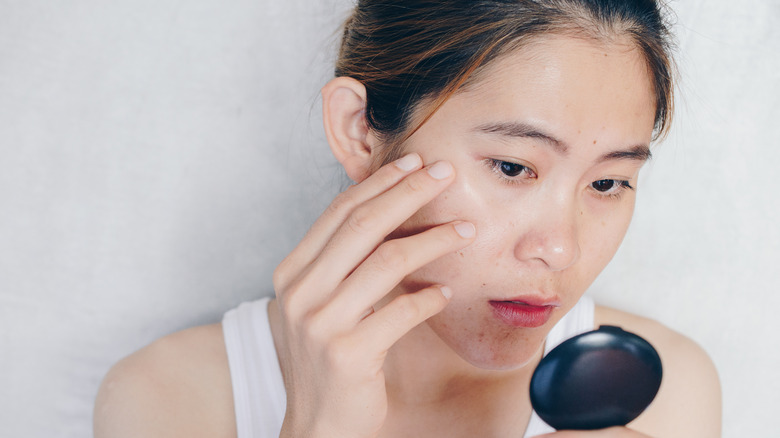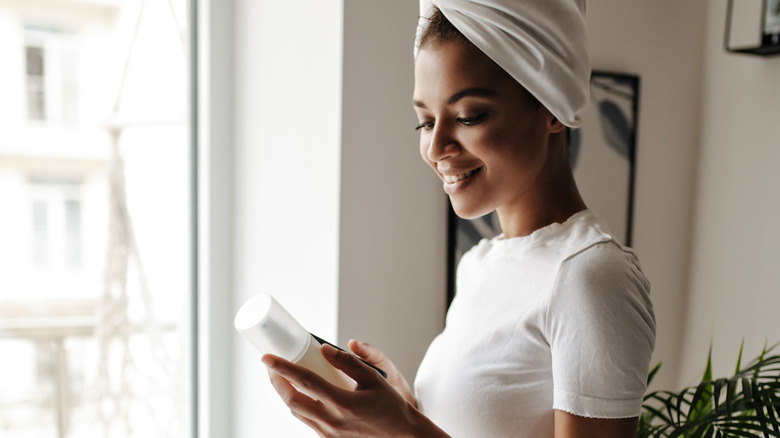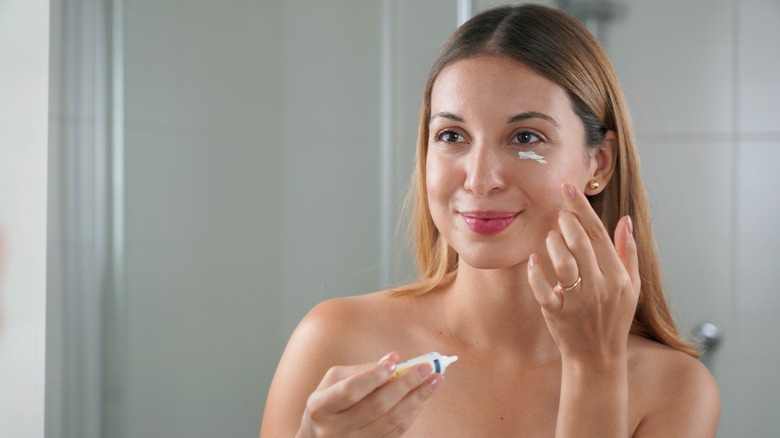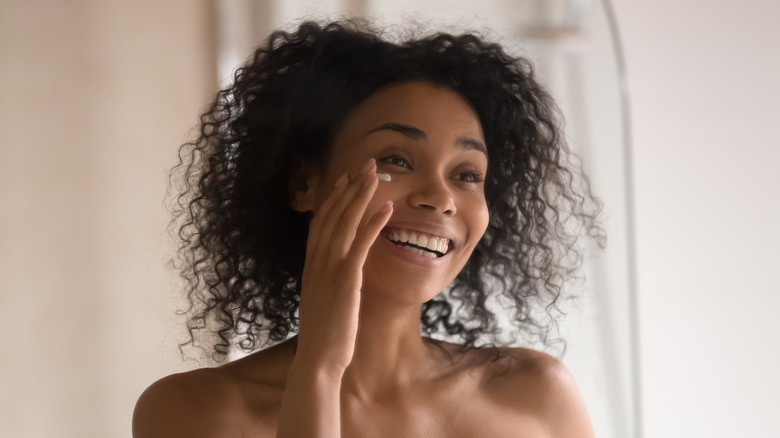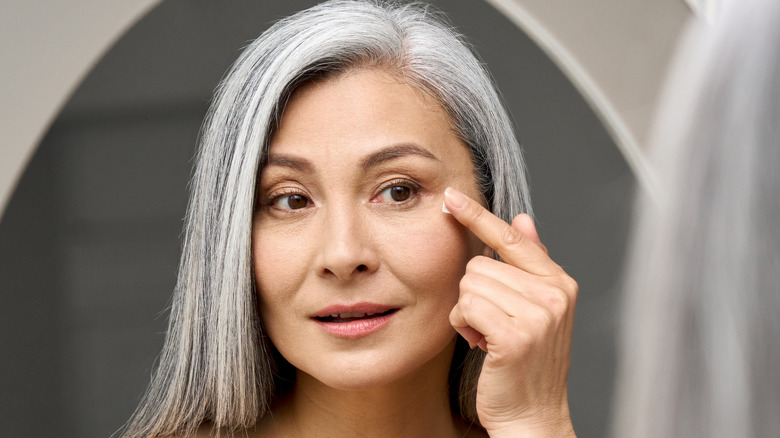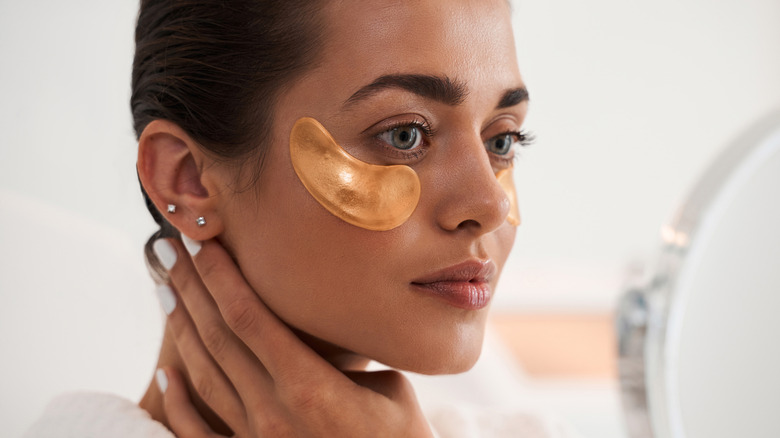Can Under-Eye Cream Cause Milia? Here's What We Know
We may receive a commission on purchases made from links.
Pimples, zits, blackheads — skin outbreaks are the bane of our existence, but add milia on top of the things we have to worry about and we may feel like chucking our skincare routine out the window. Like many other skin eruptions, milia are harmless and they're usually so tiny that they are unnoticeable. Some people may have clusters of milia, while others may just see one milium on their skin. So, what exactly are they?
According to Healthline, milia are tiny white bumps that are formed by keratin buildup and become cysts on your face. Dealing with milia can be frustrating, as they're not easy to squeeze out like a pimple. In fact, many have to go to a dermatologist in order to get them extracted.
There are several causes of milia. Some babies are born with them, but they usually go away on their own. However, with adults, the bumps may be caused by irritation to the skin via dermabrasion or laser treatments, and they can be harder to eliminate. Additionally, moisturizers that are too occlusive can contribute to milia, so if you're finding white bumps around your eye area, your under-eye cream may be the culprit.
Check your eye cream for milia-causing ingredients
The skin around our eyes is delicate and thinner than the rest of our face so that area often needs a bit more TLC. Eye creams are formulated to give your under-eye area more hydration to prevent fine lines and swelling. However, if you find yourself plagued with milia around your eyes, it may be that the ingredients in your eye cream are clogging your pores and not allowing natural exfoliation to happen, thus causing keratin buildup.
To prevent milia, avoid any mineral oils in your eye creams, such as petroleum and paraffin oils, as well as lanolin. Heavy moisturizing agents such as beeswax, squalene, and dimethicone can also contribute to milia. While these ingredients are super dense and prevent water loss from your skin, their occlusive properties can mean clogged pores. While it may seem natural to hydrate your under-eye area with thick cream, if you're prone to milia, you'll want ingredients that are humectants.
Look for humectants as opposed to occlusives
While occlusives are designed to trap water in the skin, humectants draw moisture from the air onto your skin and help retain it to keep you hydrated. They also draw out water from the deeper layers of your skin to the surface. Some examples of humectants are alpha-hydroxy acids, hyaluronic acid, salicylic acid, glycerin, and urea. These ingredients have exfoliating properties which are great for preventing milia. They also help plump up the skin around our eyes, giving them a more youthful appearance.
When using an eye cream with humectants, it's important to apply it on an already damp face. After cleansing, use a gentle exfoliating toner that contains glycolic or lactic acid. Eye cream should go before moisturizer in your skincare routine. Gently pat your eye cream around your eye area with your ring finger. Along with humectants, look for ingredients that are lightweight and breathable.
These other ingredients can help prevent milia
The under-eye area is the most sensitive skin on our bodies so it's important that we choose skincare with ingredients that help nourish it without causing irritation. Instead of a heavy formula such as a thick cream or oil as a base for your eye cream, choose a lightweight serum that's water-based instead. In order to hydrate without clogging pores, you'll want to look for certain ingredients. Retinol helps to get rid of milia. A derivative of vitamin A, retinol is a powerhouse anti-aging ingredient in moisturizers, per Cleveland Clinic. It increases collagen and skin cell production while keeping pores free to breathe, which means saying goodbye to milia.
Peptides also boost collagen, as well as elastin, while repairing the surface of your skin. As we age, our bodies naturally lose collagen, which contributes to the loss of plumpness in our faces. Peptides help restore these proteins and can reduce the appearance of fine lines and crow's feet around our eyes. If you're using a lighter eye cream, you may be tempted to use a lot of product to add more hydration but don't go overboard. Too much can clog your pores and may be contributing to your milia.
Use your eye cream sparingly
Eye cream ingredients are highly concentrated so you don't need to glop it on. There's a reason they come in such tiny packages. If you're overdoing it with your eye cream, stop right now. Since the skin around our eyes is so thin, it absorbs products very easily. Overapplying eye cream, especially before you go to sleep, can cause you to end up with puffy eyes. Sounds counterproductive, doesn't it? Additionally, too much eye cream can end up in your eyes and irritate them.
A pea-sized amount for each eye is sufficient enough to hydrate the area without going overboard and clogging up your pores. To get the most out of your eye cream, allow it some absorption time before you move on to applying makeup. Dermstore suggests waiting about 90 seconds before you go onto your next skincare or makeup routine step. And while your eye cream may already have naturally exfoliating ingredients, in order to prevent milia, you'll want to manually exfoliate your eye area regularly.
Make exfoliating around your eyes a habit
We know we've stressed that the skin around our eyes is highly delicate but that doesn't mean it doesn't need to be exfoliated. Just like the rest of our face and body, the skin cells around our eyes regenerate and we need to gently get rid of the excess dead skin. Don't reach for your regular facial scrub, however. Opt for an exfoliating eye mask or peel that removes dead skin cells without irritating the area. You can also look for an exfoliating eye cream that contains glycolic acid, which is super gentle on the skin.
You can also massage away dead skin with a facial cloth. After allowing your skin to soften and your pores to open up in the shower, take a wet cloth and gently rub your eye area in light, sweeping motions. Be careful not to tug too hard or you'll cause the skin to stretch.
If you already have milia, it's not possible to get rid of them on your own. You'll have to visit your dermatologist and have them professionally removed. However, by changing up your eye cream and skincare routine, you'll go a long way in preventing those pesky white bumps.
